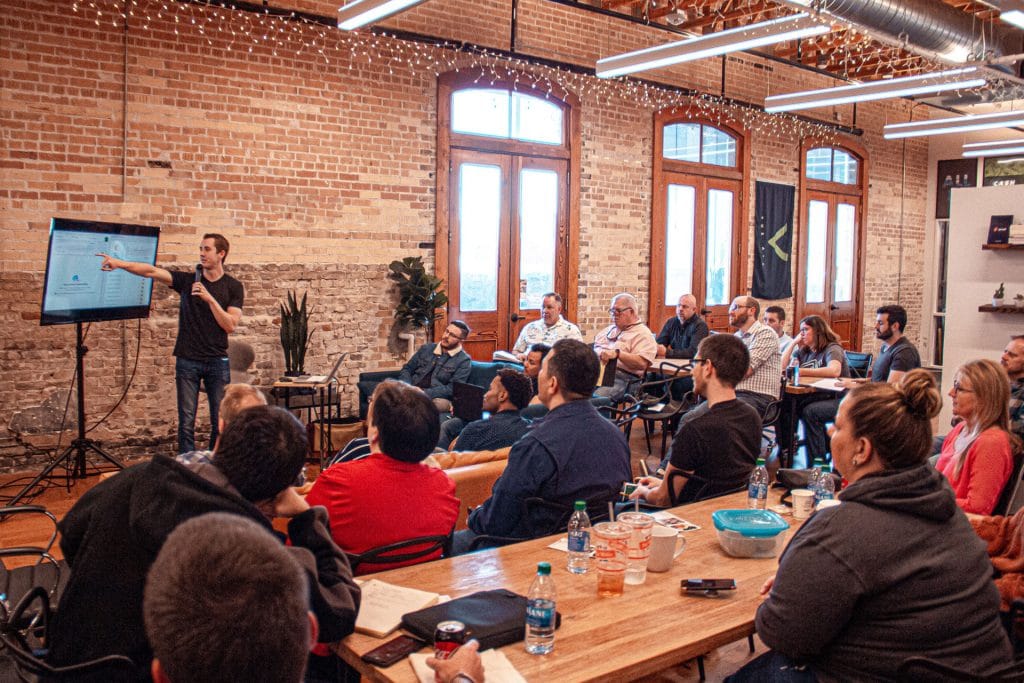Why you should get regular seminar feedback from your participants
Quite simple. With the collected feedback from your seminar participants, you have the huge opportunity to lead your course offerings to lasting success and thus catapult you to one of the top seminar providers.
All you need is a suitable feedback method, which you use over several events.
From the collected feedback, you will learn about the interests of your participants, benefit from their ideas for improvement, uncover weaknesses and optimize the event procedures and learning content in line with expectations and target groups.
If you have made adjustments to your training event based on the feedback you have received, it is important to gather further impressions and opinions from your participants.
Through the continuous process of reviewing what you have done and adapting your training event to meet expectations, you ensure its continued success.
In addition, you create an extraordinary participant experience that leads to the strengthening of customer loyalty and ultimately to the success of your seminar. Therefore, you should get regular feedback.

What are the proven methods for obtaining seminar evaluations?
Basically, there are many methods to obtain seminar evaluations from your participants.
To give you some ideas and inspiration, we have listed a selection of different feedback methods below.
These proven methods will be explained in detail.
Method 1: Online feedback form for seminar evaluation
Online research has become a very popular survey tool over the past few years.
Paper questionnaires are now digitalized using online feedback tools such as easyfeedback, given their own (corporate) design, published via various digital channels such as websites, social media or newsletters, and the collected data automatically evaluated.
It doesn’t matter whether you are a beginner or a survey professional, whether alone or in a team, whether for market research purposes, for employee and customer surveys or for the evaluation of events.

With online feedback tools such as easyfeedback, surveys can be created quickly, easily and flexibly by drag and drop in minutes. In most cases, these online feedback tools also offer ready-made templates that can either be adapted to your own needs or used immediately.
Some online survey tools such as easyfeedback also offer confidential and GDPR-compliant data protection.
If the primary goal is to strengthen the trust of the survey participants in the survey, easyfeedback, for example, also offers 100% technical anonymization of the participation.
If you have not yet conducted surveys with an online feedback tool, then try it out. Save yourself time when creating, distributing and analyzing.
Surprise your survey participants with an interactive and unique user experience for a higher response rate and more qualitative answers. Let your survey participants participate conveniently via desktop, tablet or smartphone, anywhere, anytime.
Method 2: Classical feedback form for seminar evaluation
Everyone knows the classic feedback form. It is designed by hand or on the computer using an online tool and printed out in paper form. It is then distributed (by post) and collected again after the survey participants have completed it by hand. Finally, a manual evaluation of the given answers of the questionnaire participants takes place.
As a quantitative technique for collecting data, this form of survey has proven to be a cheaper and simpler alternative to the personal interview. With a paper questionnaire, personnel costs are largely eliminated and the time required to carry out the survey is significantly less. In addition, the questionnaire can be quickly printed and multiplied to the required number.
In addition, a paper questionnaire is much more flexible in using different question types such as closed questions, scales or ranking questions, compared to personal interviews. A further advantage is also the higher chance to receive qualitative and more honest answers due to the possible anonymity in answering the individual questions.
Although a paper questionnaire, as a quantitative survey method, has many advantages, there are also disadvantages. On the one hand, there can be high costs for printing the required questionnaires and the high costs of possible postal dispatch. On the other hand, the response rate to postal mailing of the questionnaires can be lower, which has negative effects on the representativeness of the evaluated results.
A further considerable disadvantage of paper questionnaires can be the manual evaluation of the contained answers. Under certain circumstances, this can take quite a long time.
Although paper questionnaires have prevailed over face-to-face interviews due to their predominant advantages, this has gradually been replaced in recent years by the greater popularity of online questionnaires.
Nevertheless, classic paper questionnaires are actively used especially by people who are neither computer-affine nor have the technological possibilities to participate in online questionnaires.

Method 3: Feedback round
The first possibility to get constructive feedback from your event participants: to offer open discussion rounds after or during the event.
In these roundtable discussions you give your seminar participants the chance to openly discuss individual aspects of the seminar and to express praise and criticism.
This is the perfect opportunity for you as a lecturer to gather both positive and negative impressions. Above all, the feedback round should also be used to discuss the performance of the moderation and event management.
Evaluate the received constructive feedback, revise the concept and content of your event and optimize it according to your expectations.
In general, you should always allow time for a feedback session, either at the end or before the last item of the program. Any lost feedback prevents you from developing your event further.
Method 4: One-Point Method
This feedback technique is very easy to implement. All you need to use the “One-Point Method” is a specific question or statement, a long line and two opposing answers, placed at the left and right ends of the question or statement.
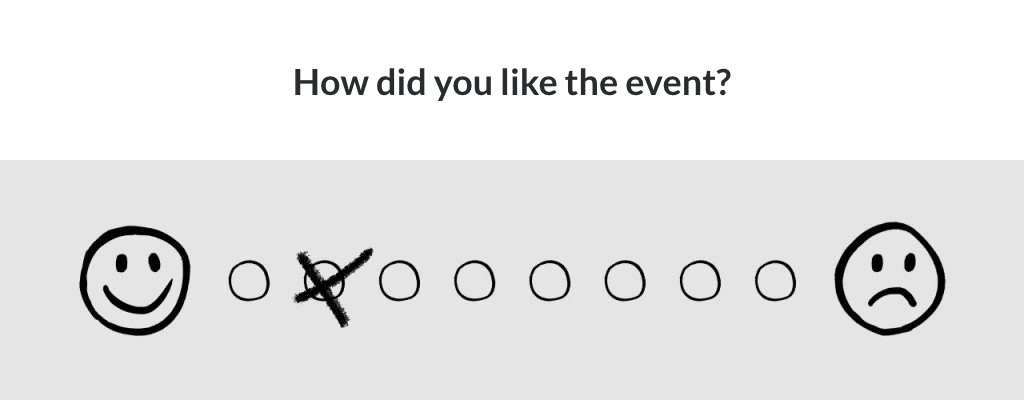
The participants of the seminar can give their feedback on the examined question or statement by simply marking on the line.
For the implementation of the one-point-feedback method, easyfeedback offers you a slider where both sides can be freely defined. By moving the slider the evaluator can easily give his feedback.
This way you already get concise feedback about things that are already going well or need optimization. In addition, the evaluation of the feedback with this evaluation tool is quick and easy, because no complicated data analysis is needed.
Furthermore, the one-point method can be used as often as you like for seminar evaluation for different questions or statements. This way you can get a first impression of your event quickly and easily, without complex effort.
Method 5: Seminar evaluation in the coordinate system
A two-dimensional scatterplot as a coordinate system allows you to ask your seminar participants to evaluate a certain topic from two evaluation aspects.
To do so, you need a square which you can display on a blackboard, a poster or in a feedback sheet. You also need a question or statement as the title of the coordinate system. The two axes are then labeled with the respective selected assessment aspects.
The square itself is divided with a diagonal line, so that a field for the respective aspects is created.
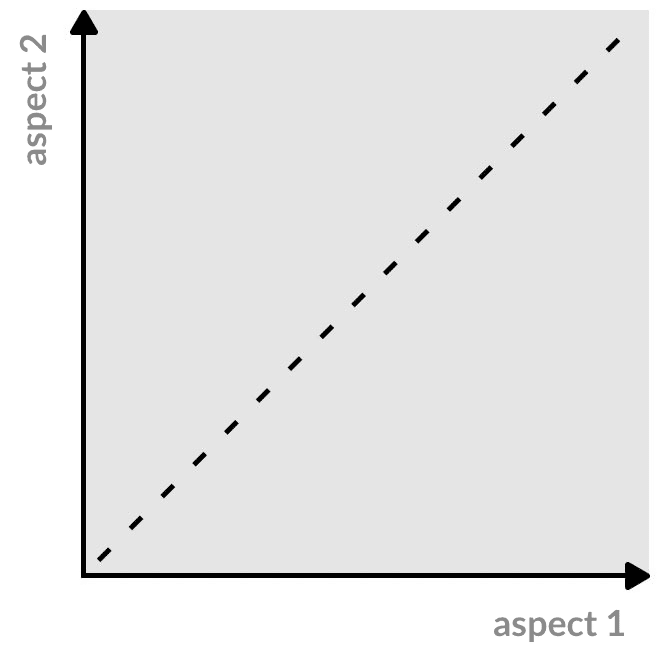
Each axis starts at zero point with the negative value. This can be represented for example with the attribute “bad” or with a sad smiley 🙁 .
The respective ends of the two axes are consequently represented with the positive value, i.e. with the attribute “Good” or with a smiling smiley 🙂 .
The event participants can now express their impression of each question or statement exactly once by sticking a dot or placing a cross in relation to the assessment perspectives.
For the subsequent evaluation, the coordinate system can help you to get a quick visual overview through the accumulation of points or crosses. Finally, the visualization can be used to determine whether there is potential for optimization.
Method 6: Evaluation poster for seminar evaluation
The evaluation poster is a quick and easy feedback method to get the impressions and opinions of your event participants at the end of an event.
The evaluation poster is hung on the door of your seminar room. This allows your seminar participants to give a seminar evaluation before they leave the room.
To rate the seminar, participants can place a cross on a scale from + to – and under the points “What did I like” and “What could be improved”. Enter comments.
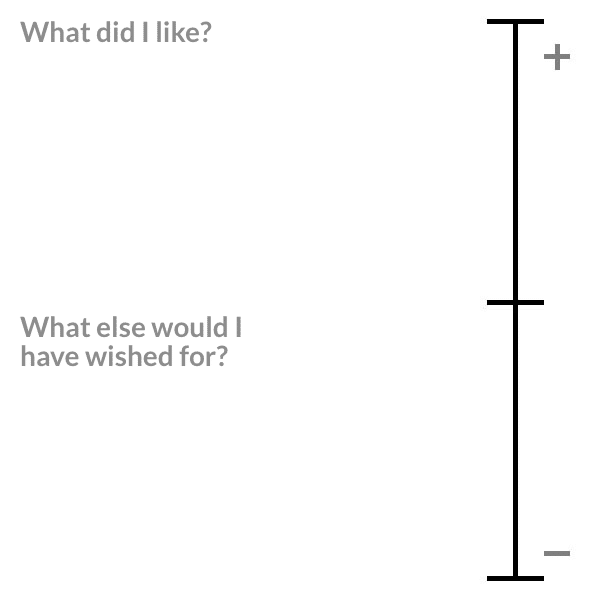
If you receive predominantly negative feedback on your event, use this feedback to improve your event step by step. If the previous criticism has disappeared in the next survey about your event, then you have done everything right.
Use the evaluation poster over several seminars and collect as many impressions and opinions as possible from your participants.
Always remember that feedback is always subjective opinions.
When you have collected enough qualitative answers, then weigh up which of the expressed improvement wishes and ideas you would like to implement for the sustainable optimization of your course.
Method 7: Five-finger feedback method
The application of this technique is very simple and is often used especially by teachers in the school context. With the help of feedback from students, the aim is to improve their own school lessons.
But also for the evaluation of seminars and events the five-finger-method can be used to continuously improve the course of events and learning content. To use it, you only need the five fingers of your right or left hand.
With this method, each of the five fingers represents a specific question or statement. Which finger has which meaning is listed below:
- Thumb: I liked that very much! What did I like best?
- Index finger: That can be done better! What should one respect?
- Middle finger: I did not like that very much! What must be improved?
- Ring finger: I will take that with me! What helped me the most?
- Little finger: That came too short! Which topic/area should be given more importance next time?
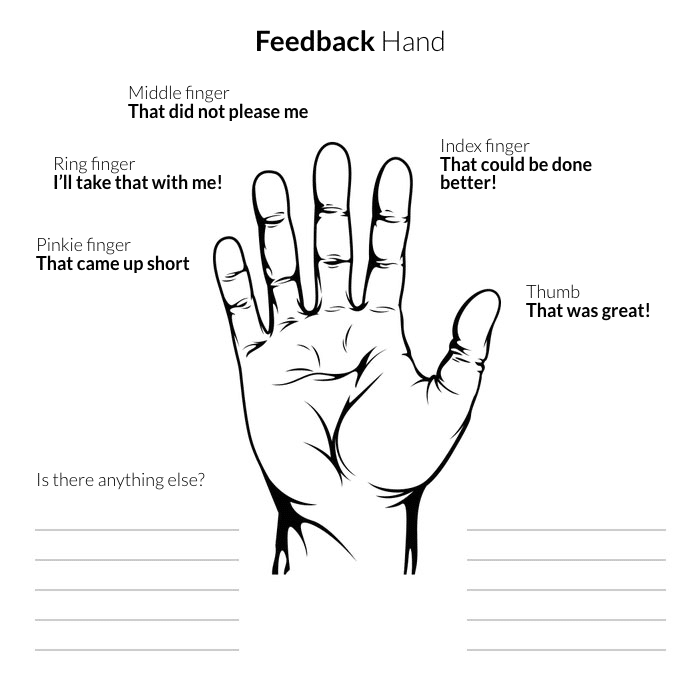
The five-finger feedback method is flexible and can be applied in writing as well as verbally, for example in an open joint discussion with your seminar participants.
If you prefer anonymity in evaluating your seminar, your seminar participants can, for example, draw the outline of their left or right hand on a piece of paper, enter the question or statement about each finger and then add their feedback in writing.
Method 8: Four-field evaluation matrix
The four-field or cross-hair matrix is another feedback technique to obtain the potential of constructive feedback for success-oriented and sustainable improvement of the seminar event.
All that is needed is a crosshair consisting of two intersecting lines, an evaluation topic and two extremes at each end point of the two lines. This can now be created for a variety of evaluation aspects.
Your event participants now enter their personal assessment for each of the evaluation topics questioned in one of the four fields by a dot. At the end you will receive an overview of the perception of your event and learning content.
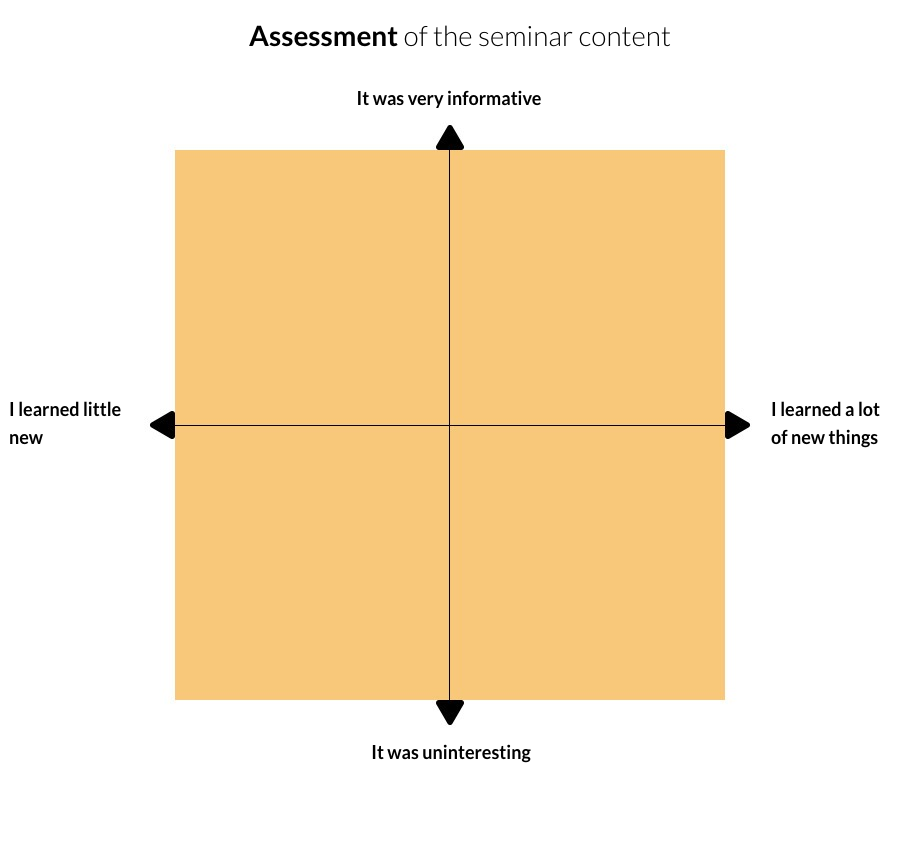
Method 9: Evaluation target
Ever heard of the evaluation target? If not, then read on carefully.
The evaluation target is a visual feedback method. Several evaluation aspects of a question or statement are shown in a circular representation – a kind of target – with differently drawn circular segments.
The different circle segments represent different evaluation levels. The closer a circle segment is to the center, the more positive is the evaluation level. The most positive value is in the center of the circle.

The seminar participants can now place a cross or a point in one of the circle segments for each of the different aspects of the assessment and thus provide feedback on the topic questioned.
At the end, the overall result of the evaluation is immediately visible through the visualization of the impressions. If desired, this can be discussed with the participants to gain even deeper insights.
Method 10: SOFT feedback method
The SOFT method is an interactive evaluation tool that allows your seminar participants to give their opinion in writing or orally on four different areas of analysis.
These analysis areas are equipped with guiding questions and are divided into the points Satisfaction, Opportunities, Faults and Threats.

The SOFT method is ideal for questioning seminar participants both individually and in small groups. The point is to collect both positive and negative feedback and thus to identify chances as well as problems of your training event through detailed feedback.
Record the results of the SOFT survey and, if necessary, define appropriate measures to improve your event.
Which seminar feedback method should I use?
As you have read before, there are numerous possibilities which can help you to get constructive feedback from your seminar participants for a sustainable and success-oriented optimization of your course.
As varied and numerous as the possibilities are, in the end it is all the more difficult to decide on the right feedback method.
To make sure you are not left out in the rain, we have put together ten questions to help you choose the right feedback method. These should help you to make a decision.
- How old is your participant group?
- How large is your group of participants?
- How would you like to get participant feedback? Playful or rather factual?
- How much time do you want to give the seminar participants for their feedback?
- What goal do you want to achieve with the seminar survey?
- How detailed would you like to receive feedback from the seminar participants?
- What information do you need to achieve the goal of your seminar survey?
- Do you want to collect the seminar feedback automatically or manually?
- How much time would you like to spend on the evaluation of the seminar evaluation?
- Do you need a visual representation of the collected seminar evaluation?

Conclusion: Get the desired seminar feedback with the right methods
You don’t need witchcraft to offer a successful seminar or event. You only need feedback.
In this article I have shown you which methods you can use to obtain valuable feedback for the expected and target group-oriented optimization of your training event. Every feedback technique has its advantages and disadvantages.
Therefore, test the different feedback methods mentioned in this article and find the right one that fits you, your survey goal and your event.
Don’t miss the chance to become a top seminar provider and get the inspiration and improvement suggestions from your participants.
More on the topic of event & seminar surveys:
- Blog
- Event & Seminar Survey Templates
- More

